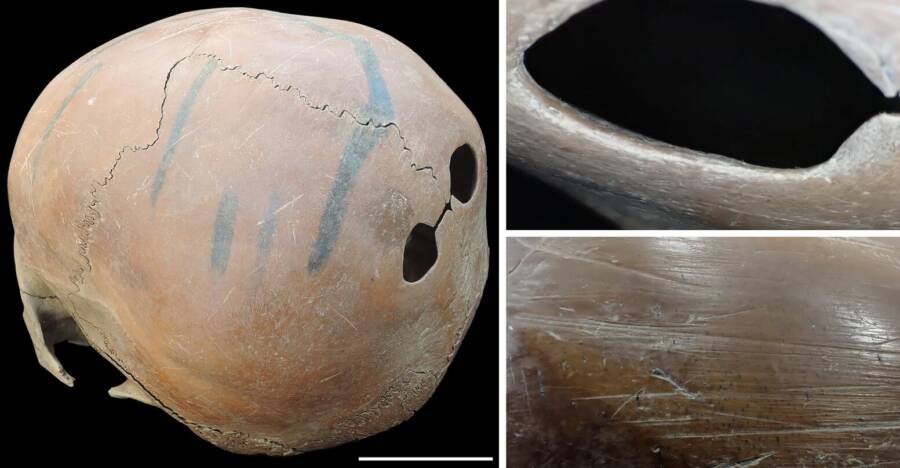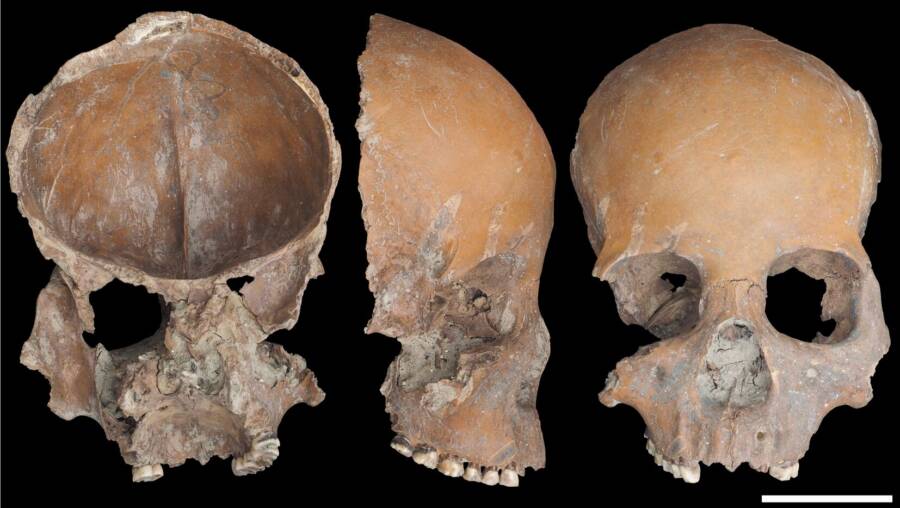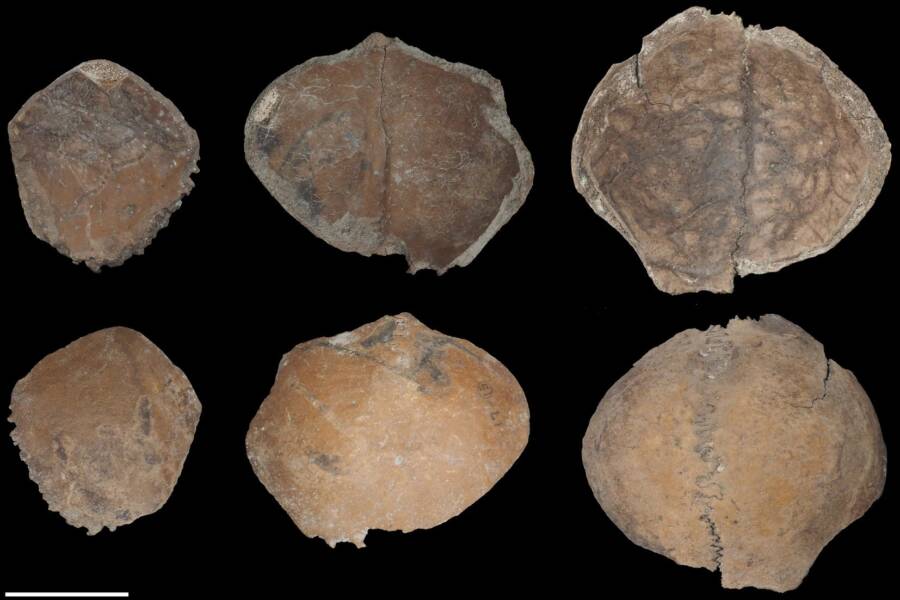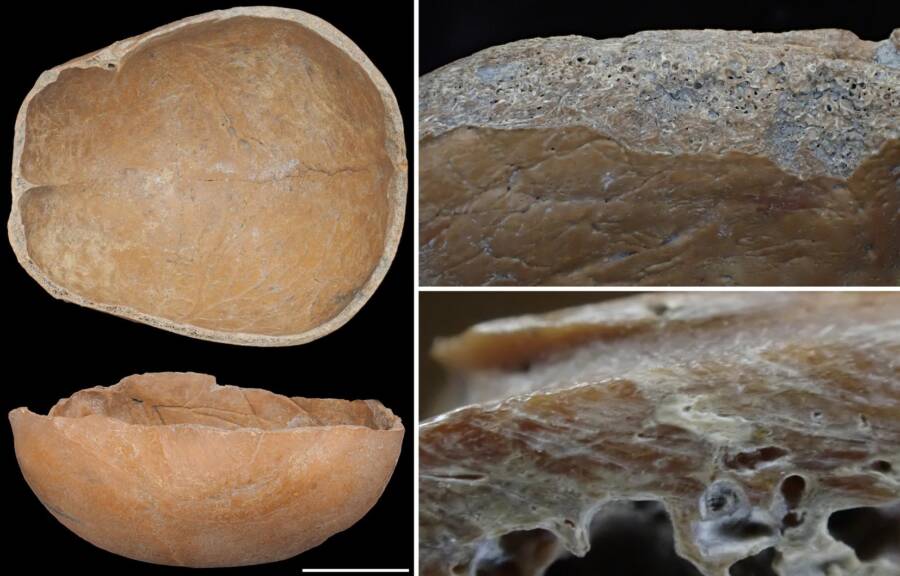Many of the bones were discarded in canals or moats, suggesting they were seen as disposable and not revered as human remains.

Sawada et al. 2025One of the skulls analyzed during the study has two perforations and appears to be highly polished.
During a study of almost 200 human bones from China’s Neolithic Liangzhu culture, researchers made a surprising discovery: Several dozen of them showed some kind of modification. The bones had been perforated, split, ground down, or polished. Though seemingly discarded before completion, some formed skull “masks,” while others were crafted into skull “cups.”
Many questions remain about this curious find, but researchers suspect that the modified bones are related to prehistoric rituals and changing attitudes toward death in increasingly urban settings.
The Bones Of The Neolithic Liangzhu Culture
According to a study published in Scientific Reports, 183 bones were discovered during studies at Neolithic Liangzhu culture sites in southern China’s Yangtze River Delta. The bones date back to between 5,300 and 4,500 years ago, and 52 of them had seemingly been modified in some way.
“At the Liangzhu sites we investigated, many of the human bones exhibit clear evidence of artificial modification, including distinct percussion marks, cut marks, and scraping traces that cannot be explained by natural processes,” Junmei Sawada, the lead author of the study, told All That’s Interesting in an email. “Thus, there is no doubt that these bones were intentionally processed by humans.”

Scientific Reports One of four skulls that was seemingly modified into a mask.
The prehistoric bones had been modified into skull cups, masks, and plate shapes. Some skulls had perforations, jaw bones had flattened bases, and limb bones showed signs of having been flattened, cut, or cracked. Several had seemingly been highly polished.
The bones belonged to a wide range of ages and sexes — researchers discovered remains from both men, women, and children. And the bones, lacking cut marks, were seemingly harvested long after death.
“There were no signs of violence, no cut marks on the bone surface that could be interpreted as disarticulation marks, and no evidence of burning,” the researchers wrote in their study.
Yet, most of the bone items were apparently discarded before they were finished. The researchers noted that 80 percent were seemingly incomplete when they were tossed into nearby canals and moats.

Scientific ReportsSkulls that were seemingly modified into plates.
“[T]he purpose of these modifications… remains a fascinating and complex question,” Sawada told All That’s Interesting.
“Many of the modified bones appear to be unfinished, and a considerable number were discarded into canals. These observations suggest that the bones were not treated with special reverence. Therefore, unlike other prehistoric contexts around the world where modified human remains have been linked to ancestor worship or ritual practices, we find little positive evidence to support such an interpretation for the Liangzhu case.”
But researchers have some ideas about who they may have belonged to and what purpose they may have served.
The Mysterious Purpose Of The Neolithic Liangzhu Bones
China’s Liangzhu culture emerged around 5,300 to 4,500 years ago along the Yangtze River Delta. It’s one of the earliest — and largest — walled urban societies in the country. Liangzhu settlements are quite sophisticated, with cemeteries, dams, canals, altars, workshops, and palaces.
So, why did its people modify bones and then discard them?

Scientific ReportsSkulls modified to make what appear to be cups.
Because the Liangzhu culture left no written record, the answer has to be based on some historical guesswork. For example, historians know that skull cups, similar to the ones in the study, were previously found at burials of high-status Liangzhu citizens. As such, the discarded bones could have held some ritual or religious significance.
However, researchers found that the bones in their study showed signs of poor health and nutrition, suggesting that they belonged to lower classes.
Their hypothesis is that the discarded bones were seen as easily accessible raw material — and that this was directly connected to the growth of an urban society. The bones possibly belonged to some kind of “other,” either lower-class people or foreigners, whose anonymity in a large urban society with weak social ties led to their bones being used for another purpose.
“We propose that the emergence of urban society in Liangzhu — characterized by population growth, migration, and increasing social complexity — may have led to the weakening of close interpersonal relationships that had previously existed in smaller communities,” Sawada explained to All That’s Interesting. “In this new social context, the concept of the ‘other’ may have arisen, and this shift could underlie the ways human remains were treated and modified.”
Sawada and his team are eager to learn more. Their next step will be a more intensive study of the modified bones, to better understand who the individuals were, and why their bones were used as materials.
After reading about the modified bones found at Neolithic sites in China, discover the astounding story of the terracotta warriors, the thousands of life-like sculptures made to “guard” an ancient Chinese emperor. Or, learn about “Lady Dai,” the incredibly well-preserved Chinese mummy from the third-century Han Dynasty.





